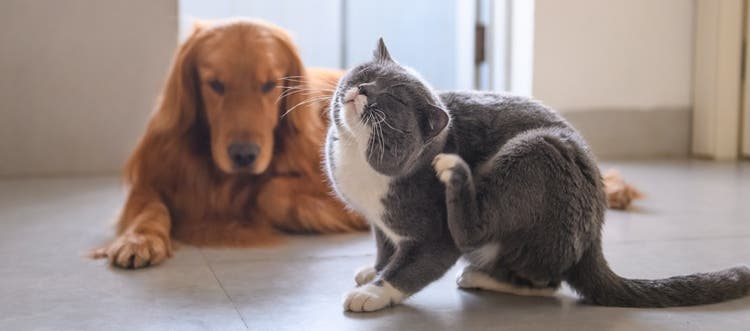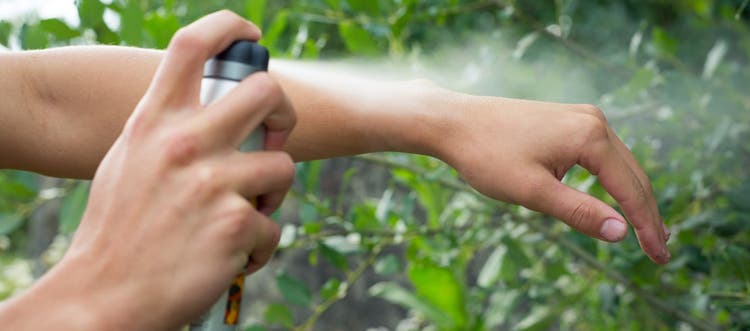Common causes of bumps on dogs and cats.
Just like you, sometimes cats and dogs develop skin conditions seemingly out of nowhere. If you’ve recently found a skin abnormality on your pet, be sure to talk to your vet. However, also keep in mind that sometimes these skin conditions turn out to be normal, harmless growths. Here are several examples of common pet skin abnormalities and how to identify them.
Common Dog Skin Conditions
First rule of thumb (or dewclaw, if you will): If you spot something abnormal on your dog, see your vet. Only your vet can give you an official diagnosis and treatment.
Secondly, regularly using preventive measures to keep fleas and ticks at bay can help rule out parasites as the cause of a bump.
And finally, dogs are more prone to skin abnormalities than cats, especially when it comes to growths such as skin tags and warts. Here are some of the more common abnormalities you may find on your pup.
Bumps Under My Dog’s Chin — Is It Dog Acne?
Just like teenagers are more prone to acne, so are younger dogs — dog acne is most common in short-hair breeds between the ages of 6 months and 1 year. If you notice red bumps under your dog’s chin and elsewhere on their muzzle and lips, it could be dog acne.
Dog acne is an inflammatory disorder. According to PetMD, it may start as folliculitis, which is when the short hairs on your dog’s muzzle and lips push below the surface and become inflamed. Acne may also be the result of furunculosis, which is when the hair follicle under the skin of your dog’s muzzle and lips becomes infected. If the acne worsens, sometimes the bumps become infected and your dog’s muzzle can swell.
A couple of other conditions can mimic this skin condition, so if you suspect dog acne, take your dog to the vet. Treatment may include topical or oral medications, and your vet may also give you tips on how to keep your dog from rubbing the area and how to keep the area clean.1
Warts — Common on Older Dogs (and Puppies!)
Warts on dogs often are small, round and have a cauliflower-like texture. Your vet may refer to warts as papillomas as most are caused by infection with papillomaviruses. There are many different types of papillomas, and warts can differ in shape, size, color, texture and location. Any breed is susceptible to warts, some more so than others.
Dogs who are immunosuppressed or spend a lot of time around other dogs are more at risk as warts are contagious. Younger dogs tend to get warts in their mouths, while older dogs tend to get warts on their skin. Often warts will dry and fall off on their own.
Sometimes medications or surgery are necessary, especially if the warts are causing problems, such as eye irritation, difficulty eating or swallowing, or lameness. Rarely warts that don’t resolve independently can turn into cancerous tumors. Talk to your vet if a wart has been present for more than three to five months.2-4
Sebaceous Cysts — Pimple-like Bumps on Dogs
You might mistake sebaceous cysts for warts or pimples. These cysts are small and, according to the American Kennel Club, form from blocked oil glands. They are common in breeds with fine hair. You may see a pasty white substance if or when the cyst bursts. Do not try to pop, squeeze or poke the cyst at home.
If you’re concerned, talk to your vet about a treatment plan. These cysts typically disappear on their own, but if they become infected, they can be surgically removed.5
Dog Lipoma — Don’t Worry, It’s Not Cancer
Lipomas in dogs are noncancerous (benign) tumors — harmless lumps born in fat cells — often found on a dog’s trunk and legs. As they accumulate more fat, lipomas grow, sometimes becoming quite large. All breeds are susceptible, although lipomas are more common in larger breeds and older dogs, and tend to be larger in overweight dogs.
Your vet can diagnose a lipoma by using a fine needle to collect cells and verifying it contains fatty tissue. Your vet may leave a lipoma alone unless its interfering with your dog’s movement, affecting blood supply or causing pain. Lipomas can be surgically removed.2,5-7
Abscesses in Dogs — Ouch!
Skin abscesses in dogs can be painful for your pup. They can form after your dog steps on something sharp, is bitten by a bug or animal, or gets a splinter. They also can form around infected glands or sores, or from excessive licking due to skin allergies. If the wound heals and bacteria or debris are trapped, a fluid-filled lump can form. Your dog may wince if you touch an abscess.
Take your dog to the vet if you suspect an abscess. Your vet may use a fine needle to collect cells and examine them. Antibiotics are typically the first course of action.5,8
Skin Tags in Dogs — Often Harmless, but Watch for Changes
A skin tag on your dog may look like a small bump or flap of skin. According to the American Kennel Club, they’re caused by overactive cells called fibroblasts. Skin tags can affect dogs of any age or breed.
Skin tags are often harmless, but still get them checked out by your vet, who may want to do a biopsy. Skin tags are more concerning if, similar to human moles, they change in size, shape or color.5
Mast Cell Tumors in Dogs
Mast cell tumors are the most common cancerous (malignant) skin tumors found in dogs. They can be found in dogs of any age (although most affected dogs are middle-aged), often on the trunk, limbs, head and neck. Mast cell tumors are often irregular in shape and feel solid when you touch them.
If you suspect a mast cell tumor, contact your vet. Your vet will likely remove the tumor and perform a biopsy to determine the next steps.2,5,9
Common Cat Skin Conditions
The same rule applies for cats as it does for dogs: If you spot something abnormal on your cat, see your vet — only they can provide an official diagnosis and treatment.
Likewise, if you’re wondering if a bump or lump is a tick or flea, preventive collars can help. Regularly using preventive measures to keep fleas and ticks at bay can help rule out certain skin abnormalities.
Here we cover some of the more common bumps you may find on your cat.
Are Those Bumps Under My Cat’s Chin Considered Cat Acne?
If your cat has pimple- or blackhead-like bumps under their chin or on their lips, either red or black (like dirt) in color, it could be cat acne. Cat acne can affect cats no matter their age, sex or breed. According to PetMD, if the hair follicles on your cat’s chin produce too much keratin and become clogged, they can become infected and form pimples.
Cat acne can be chronic, which can lead to follicles that fuse together and crust or rupture, as well as soreness and hair loss. Although you may be tempted, don’t pick at your cat’s acne. Visit your vet instead. They can advise treatment, which often includes oral or injectable antibiotics and topical wipes or shampoos. Your vet can also advise you on how to care for your cat until the condition has improved.10,11
Is a Cat Lipoma Like a Dog Lipoma?
Although lipomas are more common in dogs, cats can get them, too. These noncancerous (benign) tumors are often found on a cat’s chest, abdomen, neck, back or upper legs. They are typically soft to the touch and are common in older cats. Experts have different stances on whether obesity is a risk factor.
Your vet can diagnose a lipoma by using a fine needle to collect cells and verify that they contain fatty tissue. Your vet may leave a lipoma alone unless, due to its location, surgical removal is necessary.12,13
Abscesses in Cats: Are They Similar to Dogs?
A red, swollen spot on your cat could be an abscess. These can be painful for your feline friend. Your cat may show signs of fatigue and may not eat as much when dealing with an abscess. They tend to form when your cat has been bitten or scratched and therefore are more commonly found on outdoor cats who may get into fights.
If you suspect an abscess, take your cat to the vet. Your vet may trim your cat’s hair around the abscess, drain it and prescribe an antibiotic and anti-inflammatory medication. Some abscesses require surgery.10,14
Horned Paw in Cats
Also called cutaneous horns, these growths are called horned paws for good reason — they look like horns and they can grow out of your cat’s paws. According to PetMD, they are caused by keratin overgrowth within the skin.
Usually horned paws are harmless, but if they become infected your vet can trim or even surgically remove them.14
Breast Cancer in Cats
Breast cancer is one of the most common types of cancer affecting cats. These tumors are located on the underside of the cat, near the nipples. They will feel hard and small at first, and will sometimes go unnoticed until they’re larger.10
About 85% of feline mammary tumors are malignant, and early diagnosis and treatment are vital. You can reduce breast cancer risk by 90% by spaying your cat before they go into heat for the first time.10
It’s always concerning to feel an unusual bump, growth or blemish when petting your dog or cat. Having a general idea of the more common bumps found on cats and dogs can take away some of that anxiety. Still, it’s always a good idea to visit your vet.
Resources
- Simonson, A. “Dog Acne” (February 7, 2022). PetMD. https://www.petmd.com/dog/conditions/skin/c_dg_acne
- Manucy, T. “Lumps, Bumps, and Cysts on Dogs” (August 30, 2022). PetMD. https://www.petmd.com/dog/symptoms/lumps-bumps-and-cysts-dogs
- Reiter, A.M. “Papillomas in Dogs” (October 2022). Merck Manual Veterinary Manual. https://www.merckvetmanual.com/digestive-system/diseases-of-the-mouth-in-small-animals/papillomas-in-dogs
- Coates, J. “Warts in Dogs” (November 3, 2022). PetMD. https://www.petmd.com/dog/conditions/all-about-dog-warts-types-causes-and-treatments
- Bauhaus, J. “Dog Skin Lumps & Bumps: When You Should Worry” (September 15, 2021). American Kennel Club. https://www.akc.org/expert-advice/health/dog-skin-lumps-bumps-when-you-should-worry/
- “Fatty lumps and lipomas in dogs” (December 9, 2019). Blue Cross. https://www.bluecross.org.uk/advice/dog/health-and-injuries/fatty-lumps-and-lipomas-in-dogs
- Weishaupt, J. “What to Know About Lipoma in Dogs” (December 9, 2021). Fetch by WebMD. https://www.webmd.com/pets/dogs/what-to-know-lipoma-in-dogs
- Kos-Barber, H. “Abscesses in Dogs” (March 2, 2022). PetMD. https://www.petmd.com/dog/conditions/skin/c_dg_abscessation
- “Mast Cell Tumors” (accessed December 5, 2022). American College of Veterinary Surgeons. https://www.acvs.org/small-animal/mast-cell-tumors/
- Fields, L. “Skin Lumps and Bumps in Cats” (July 27, 2021). Fetch by WebMD. https://www.webmd.com/pets/cats/cats-lumps-bumps-skin
- Schaible, L. “Cat Acne” (October 20, 2021). PetMD. https://www.petmd.com/cat/conditions/skin/c_ct_acne
- Villalobos, A. “Tumors of the Skin in Cats” (October 2022). Merck Manual Veterinary Manual. https://www.merckvetmanual.com/cat-owners/skin-disorders-of-cats/tumors-of-the-skin-in-cats#v3247140
- Schaible, L. “Cat Lipomas” (October 21, 2021). PetMD. https://www.petmd.com/cat/conditions/skin/c_ct_lipoma
- Grzyb, K. “Cat Skin Lumps, Bums, and Cysts” (July 25, 2022). PetMD. https://www.petmd.com/cat/symptoms/cat-skin-lumps-bumps-and-cysts
- “Feline Mammary Tumors” (accessed December 6, 2022). The Ohio State University Veterinary Medical Center. https://vet.osu.edu/vmc/companion/our-services/oncology-and-hematology/common-tumor-types/feline-mammary-tumors











